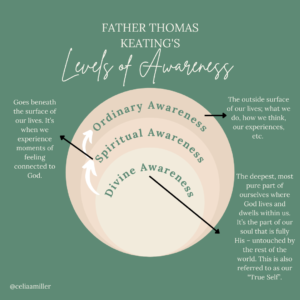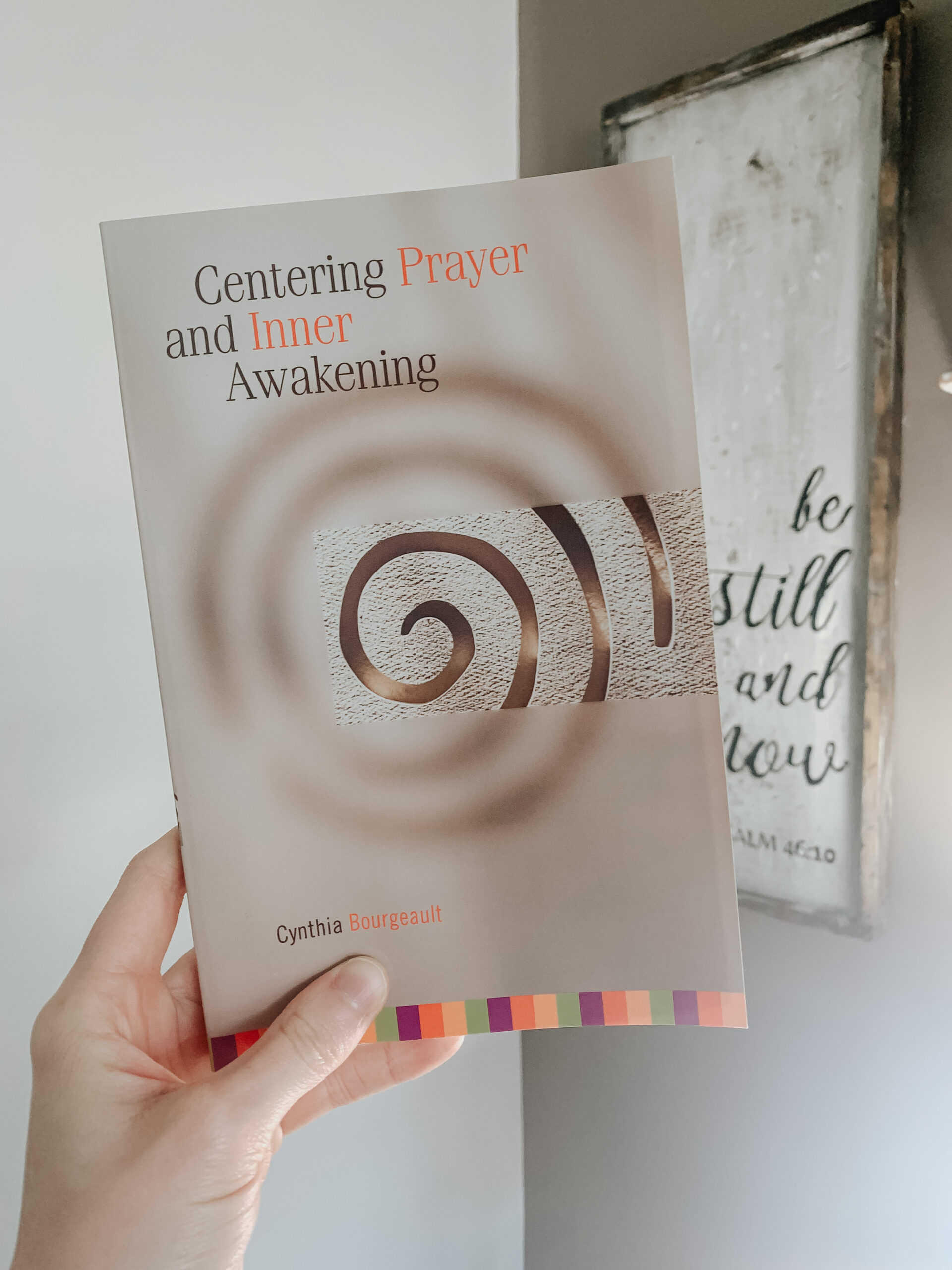An Introduction to Centering Prayer
My alarm goes off and I yawn into the darkness, shaking the drowsiness of sleep from my body.
It’s 6 am as I quietly slip out from underneath the warmth of my comforter, gather the dogs from their crates, and softly shut the bedroom door behind me so as not to wake my sleeping husband.
I tread lightly down the stairs and turn on a lamp in the living room as I make my way to the sliding glass door. The dogs are eager to get outside, and as I open the door, the morning greets me with blue-gray skies and a gentle, audible breeze that I can see rustling the leaves of our Dogwood tree.
Birdsong lingers and morning doves coo as I leave the screendoor open to make my tea.
I settle in on the couch with my warm mug and blanket while Henry nudges his cold, black nose against my leg notifying me that he would like to take up more space.
I set my tea down to cool, scoot over for Henry, and situate myself in a comfortable seated position.
With eyes closed and hands outstretched in a posture of receiving and surrender, I enter into my favorite part of the morning.
My mind begins to wander but then always returns to one sacred phrase, “love listens”.
Centering prayer brings rest and refreshment as I still my soul in God’s presence and allow Him to tend to my innermost being.
Centering Prayer Explained
Centering Prayer is a form of Christian meditation that places a strong emphasis on inner silence. The rising popularity of this Christian spiritual practice can be traced back to three Trappist monks of St. Joseph’s Abbey in Spencer, Massachusetts in the 1970s; Father William Meninger, Father Basil Pennington, and Father Thomas Keating.
Centering prayer could also be described as a form of contemplative prayer that centers entirely on silence as a way to open oneself fully to the presence of God.
I always thought that prayer was just talking to God, and while it is that, Cynthia Bourgeault in her book, Centering Prayer and Inner Awakening, points out that prayer is also about listening to God.
She goes even further to say,
“…contemplative prayer and centering prayer is a wordless, trusting opening of self to the divine presence. Far from being advanced, it is about the simplest form of prayer there is.”
Levels of Awareness
Father Thomas Keating, who was mentioned earlier as being one of the Trappist monks who popularized this Christian practice, explains that we all have “Levels of Awareness”.
These Levels of Awareness are depicted in a circular graph with the outer level of awareness being labeled as “Ordinary Awareness”, the second level being labeled as “Spiritual Awareness” and the third and deepest level being labeled as “Divine Awareness”.

Ordinary Awareness is described as our mind as it usually operates and thinks, and how our sense of self is tied to that way of thinking. This is everything that lives on the outside surface of our lives; what we do, how we think, our experiences, etc.
Spiritual Awareness goes beneath the surface of our lives. It’s when we experience moments of feeling connected to God; like when we stand in awe of a sunset or are overcome with the love of His presence or those moments when we catch glimpses of His glory alive within us and all around us.
Divine Awareness is the deepest, most pure part of ourselves where God lives and dwells within us. It’s the part of our soul that is fully His – untouched by the rest of the world. This is also referred to as our “True Self”; transcending the outside world, our experiences, and our own way of thinking and being fully whole and open in the presence of God.
You may be wondering at this point what these Levels of Awareness have to do with Centering Prayer. And in her book, Centering Prayer and Inner Awakening, Cynthia Bourgeault explains,
“As we move toward center, our own being and the Divine being become more and more mysteriously interwoven.”
Centering prayer is one way we can connect intimately with the Divine and tap into that Divine Awareness as a way of opening ourselves up to spiritual formation; the process of becoming more like Jesus.
Centering prayer is one way we can connect intimately with the Divine and tap into that Divine Awareness as a way of opening ourselves up to spiritual formation; the process of becoming more like Jesus.
Tweet
As we become more aware of the Divine within, that awareness begins to affect our Spiritual Awareness and Ordinary Awareness. It’s much like Paul’s words in Philippians 3:12-13,
“...continue to work out your salvation with fear and trembling, for it is God who works in you to will and to act in order to fulfill his good purpose.” (NIV)
In layman’s terms, engaging with the Christian spiritual practice of Centering Prayer is opening up to the transforming power of the Holy Spirit so that we can look and act more like the One dwelling within us; Divine Awareness pours into our own Spiritual Awareness and displays itself in our Ordinary Awareness (daily lives).
How to Practice Centering Prayer
Now, let’s talk about what practicing Centering Prayer actually looks like.
I stand by Cynthia’s words earlier that contemplative prayer is one of the simplest forms of prayer there is. Even if you’re just beginning your spiritual journey or have never practiced Centering Prayer before, you can easily start today!
Centering Prayer is a simple practice because it only requires a willing heart, a quiet space, a comfortable seat, and a sacred word. Centering Prayer can really be broken down into 5 simple steps.
Step 1: Open Yourself Up
There are no prerequisites required to practice Centering Prayer other than the desire to open yourself up to the Lord as a way to deepen your awareness of His Spirit within you and all around you.
1 Corinthians 6:19 is a beautiful picture of how close to God we really are, and how He aches to know us deeper still,
“Do you not know that your bodies are temples of the Holy Spirit, who is in you, whom you have received from God? You are not your own;” (NIV)
God longs to enter into a relationship with you, friend, where He can lead and transform you into the person He created you to be. So that He can “work in you to will and to act in order to fulfill his good purpose.” (Philippians 2:13, NIV)
Steps 2 & 3: Find a Quiet Space & A Comfortable Seat
Oftentimes in the New Testament, we find Jesus “withdrawing to lonely places to pray”. (Luke 5:16, Luke 6:12-13, NIV)
And in Matthew 6:5-6, He gives us a roadmap to prayer and a great explanation of Centering Prayer,
“When you pray, don’t be like hypocrites. They love to pray standing in the synagogues and on the street corners so that people will see them. I assure you, that’s the only reward they’ll get. But when you pray, go to your room, shut the door, and pray to your Father who is present in that secret place. Your Father who sees what you do in secret will reward you.” (NIV)
Centering Prayer requires solitude and silence, so it’s important to find a quiet space where you can sit alone in silence for 10-20 minutes. Afterward, you’ll close your eyes, open your hands in a posture of receiving, and then invite the Holy Spirit into that space with a short prayer.
Once you’ve done this, you’ll simply sit and rest in God’s presence for 10-20 minutes as you try to let go of any surface-level thoughts and empty yourself of you as you focus only on the Holy Spirit.
Step 4: Choose a Sacred Word
As I said in Step 3, Centering Prayer is about trying to empty your mind of you and let go of any thoughts that try to creep in. Centering Prayer differs from other forms of Christian meditation because it doesn’t require that you focus on one specific thing or Bible verse.
The whole intent is to create inner stillness and silence, letting go of your thoughts in the process so that the Holy Spirit can tend to places deep within you.
So that He can meet you in that secret place.
But, we’re human, and thoughts will creep in whether we want them to or not! The key to Centering Prayer is not to fight your thoughts or shame yourself for having them, but to kindly acknowledge them and then return back to God using your “Sacred Word”.
The “scared word” described in Centering Prayer is one single word, or a very short phrase, that you return to once a thought creeps in. This sacred word is sacred to you because it’s to be the same word or very short phrase you use every time you engage with this practice.
For me, my sacred phrase is “love listens”. When I first started engaging with Centering Prayer, I played around with a few different phrases and words until I landed on this one. It just felt right, and to me, God is Love and everything was created and formed within Love, including me.
Love always listens and invites us to listen as well.
This phrase reminds me of who I am and Whose I am, and it’s what I use to bring me back to center when my mind begins to wander.
Step 5: Put It Into Practice
Now that you have the desire to try this practice, a comfortable, quiet space, and a sacred word or phrase, it’s time to give Centering Prayer a try!
As I’ve said over and over again, Centering Prayer is about opening yourself up to the Holy Spirit as He moves and works within you. If you struggle to clear your mind as you first start this practice, please know that’s totally normal.
And if you feel like all you did for the entire 10 or 20 minutes of doing Centering Prayer is struggle with your thoughts, or struggle to quiet your mind, and you feel exhausted at the end, then you, my friend, are doing it right.
The effects of Centering Prayer are not always felt in the moments of engaging with it, and Cynthia Bourgeault would agree. She says,
“What goes on in those silent depths during the time of Centering Prayer is no one’s business, not even your own; it is between your innermost being and God; that place where, as St. Augustine once said, “God is closer to your soul than you are yourself.” Your own subjective experience of the prayer may be that nothing happened – except of letting go of thoughts. But in the depths of your being, in fact, plenty has been going on, and things are quietly but firmly being rearranged. That interior rearrangement – or to give it its rightful name, that interior awakening – is the real business of Centering Prayer.”
The more you practice Centering Prayer, the more comfortable with silence you will become, and the easier it will be to quiet your inner-self and come fully awake to the presence of God in you.
My Own Experience with Centering Prayer
Now that you know how to practice Centering Prayer, I want to share with you my own experiences and thoughts regarding this Christian spiritual practice.
I was introduced to Centering Prayer by my spiritual director a little over a year ago. We practiced it together in one of our past sessions after I had shared with her that my life at the moment just felt loud.
A Question That Led to An Invitation
After those first 10 minutes of centering prayer, I truly didn’t make it a part of my everyday life up until about two months ago.
Once again, I was meeting with my spiritual director and sharing with her that my life felt rather loud again in this season. My husband and I were making a lot of lifestyle changes and removing things from our life that we felt the Lord calling us to surrender. While these changes are so good, they can still feel overwhelming, and I shared that with her.
She responded to my overwhelm with a question.
“How can you practice inclusion in this season of your life?”
What she meant was, amidst all that we were excluding from our lives at the time, what could I add to my life in this season that would be life-giving?
After our session together, I spent the next few days praying about this and presenting the question to the Lord.
His response surprised me; Centering Prayer and gratitude.
He was inviting me to engage in at least 5 minutes of Centering Prayer in the morning followed by a time of gratitude. I accepted this invitation and have been in this rhythm almost every morning for the past two months.
My Personal Thoughts & Musings on Centering Prayer
At first, I found it very difficult to concentrate even for 5 minutes. Which, if you’re just getting started with this practice, I’ve found that 5 minutes is a good place to begin.
My mind wandered, I kept switching out my sacred word and then focusing on what my sacred word should be, which you’re not supposed to do. It was kind of exhausting, to be honest.
But after a while, with a lot of grace and faith that the Spirit was working amidst my wandering, I slowly began to fall into peace.
Now, I look forward to it every single morning.
Centering Prayer centers around surrender and trust; surrendering the desire to “do” so that you can trust the Spirit and just “be”.
Centering Prayer centers around surrender and trust; surrendering the desire to “do” so that you can trust the Spirit and just “be”.
Tweet
Once you move from that place of wanting to do and just be, you’re able then to receive God and what He wants to give you and rest in His presence.
Last week, I was reading Ephesians 3:14-19, where the Apostle Paul is praying over the Ephesians. And his prayer perfectly describes the effects and purpose of Centering Prayer,
“For this reason, I kneel before the Father, from whom every family in heaven and on earth derives its name. I pray that out of his glorious riches he may strengthen you with power through his Spirit in your inner being, so that Christ may dwell in your hearts through faith. And I pray that you, being rooted and established in love, may have power, together with all the Lord’s holy people, to grasp how wide and long and high and deep is the love of Christ, and to know this love that surpasses knowledge—that you may be filled to the measure of all the fullness of God.” (NIV)
Centering prayer for me has slowly transformed from a place I go to, into a place that I live from. It’s where I emerge and remember that I am a Beloved Daughter of King Jesus and that His love for me is unbreakable.
It’s where I can feel the wounds inside me slowly healing as lies are replaced with truth and the feeling of being unwanted and unseen is replaced with irrevocable love.
And from that love, I lean into the world and try to give a little bit of it away.
Centering Prayer is a divine act of faith as you trust God to move within you even when you can’t see or feel Him; even when you feel like nothing is happening.
I recall Cynthia’s words now,
“Your own subjective experience of the prayer may be that nothing happened – except of letting go of thoughts. But in the depths of your being, in fact, plenty has been going on, and things are quietly but firmly being rearranged. That interior rearrangement – or to give it its rightful name, that interior awakening – is the real business of Centering Prayer.”
Centering Prayer brings me back to center – back to my True Self rooted in the Divine Awareness of the Holy Spirit within me.
Centering Prayer brings me back to center – back to my True Self rooted in the Divine Awareness of the Holy Spirit within me.
Tweet
Making Space for More of God
At the root of all Christian spiritual practices is the desire to be formed and refined more clearly into the image of Christ. Spiritual formation is the process of constant growth as we cultivate a deeper relationship with the Divine.
Centering Prayer is no exception to this and seeks to answer our desire to go deeper into more of God.
Writer and practicer of Centering Prayer, Stephen Barany, says,
“In centering prayer, we make space for God and then invite God into that space. Since interior silence is not a strength of our age, centering prayer will take time and patience to learn. Still, if you desire more opportunities simply to be with God or to focus your attention on God, then centering prayer will likely be worth the effort.”
In a loud world that demands we meet a certain standard like having it all together or being “boss babes”, Centering Prayer grounds us in truth.
It’s an invitation to come as you are, friend, and simply make space for more of God in your inner life.
“Silence is God’s first language”, says the sixteenth-century mystic, John of the Cross. And I believe it’s in the language of silence that we hear God speak the loudest.
I invite you today to enter into the sacred silence of Centering Prayer and make space for more of God.
xo,


